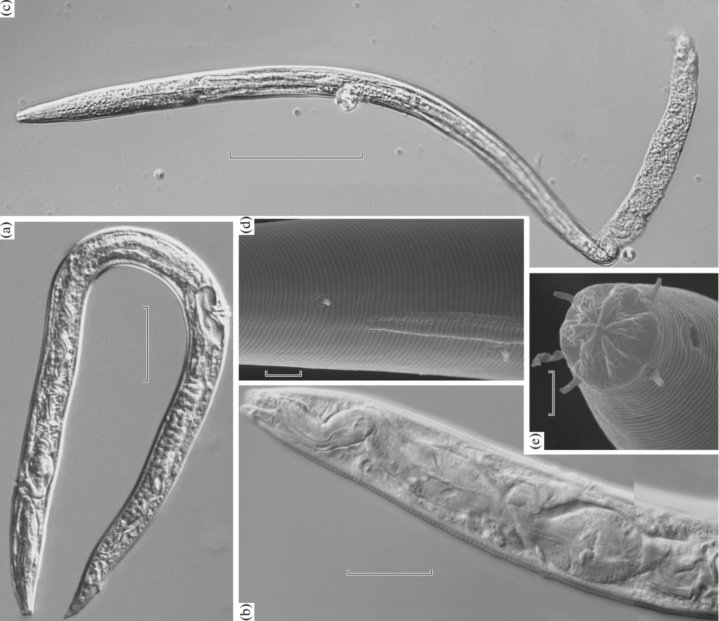生きた線虫が、シベリア永久凍土の更新世 後期の地層(4万2千年前)から回収されました。
目次
どうやって年代を特定?
論文では異なる場所で得られた2サンプルから、線虫を見つけていますが、そのうちの古かったほうに関しては、掘削により3.5mの深さから得られたコア(地質試料)の中から見つかりました。このコアには植物の残骸も含まれていて、その放射性炭素年代測定(radiocarbon dating)により、このコア中に含まれる生体試料の古さは41700 ±1400 年前と推定されました。
どうやって生き返らせた?
Permafrost samples (1–2 g) were placed into Petri dishes with the Prescott–James medium and cultivated at 20°C for several weeks [4]. The clonal cultures of nematodes were obtained from the enrichment culture.
凍土サンプル1~2g程度を、培養液を含むペトリディッシュに移し、数週間、培養したんだそうです。そうすると、線虫のクローンが回収できたとのこと。つまり、凍っていた一匹が動き出した瞬間を観察したというわけではなく、たまたまサンプル中に存在していた「生育可能な一匹」が培養中で増殖した結果、増えてきた線虫たちを観察できたということです。
研究はどれくらい大変だったの?
場所や地質年代などがことなるサンプルを300以上も試したうち、2つのサンプルから生育可能な線虫が存在したのだそうです。
線虫の種類は?
18S rRNA遺伝子をPCR法により増幅し、その塩基配列を決定して、種々の線虫の遺伝子47種と比較した結果、属はPlectusとわかり、形態学的な特徴からPlectus parvusに相当すると考えられました。もう一方のサンプル中(3万2千年前)に含まれていた線虫は、Panagrolaimus detritophagusと考えられました。
途中で混入した可能性は?
著者らはディスカッションのセクションで、季節によって仮に凍土の表面が融けることがあったとしてもせいぜい80cmくらいまでで、1.5mの深さ以上が融解することは9000年前でもなかったはずだと述べています。また3.5mの深さだと凍土は非常に固くなっており、外的な要因で外部から線虫が凍土の内部に入り込む余地はないと断言しています。
これまでの記録は?
凍った状態の線虫を生き返らせたこれまでの記録は、39年(Tylenchus polyhypnusという種)や25年半(Plectus murrayiという種)という報告がありました。これらの記録を一気に4万年以上も塗り替えたことになります。
研究の意義は?
論文中の著者らの言葉を借りれば、
the first data demonstrating the capability of multicellular organisms for longterm cryobiosis in permafrost deposits of the Arctic.
the first viable multicellular organisms, namely, soil nematodes, have been isolated from permafrost deposits.
our data demonstrate the ability of multicellular organisms to survive long-term (tens of thousands of years) cryobiosis under the conditions of natural cryoconservation.
永久凍土から多細胞生物を生き返らせることができた最初の例だそうです。この論文は、地球上で自然に生じる凍結条件のもとで数万年もの長い間、多細胞生物が生きながらえる能力を備えていることを初めて示したものです。
もし地球全体が長期間氷で閉ざされるような気候になったとしも、線虫のような動物だけは何万年でも生きながらえて、気候が好転したときに再び生命活動を再開するのでしょう。
原著論文
- Viable Nematodes from Late Pleistocene Permafrost of the Kolyma River Lowland. Shatilovich et al., 2018. Doklady Biological Sciences, 2018, Vol. 480, pp. 100–102.
参考
- シベリアの永久凍土の中で4万年も凍りついていた虫が息を吹き返す (Gigazine 2018年07月27日 13時00分)
- Viable Nematodes from Late Pleistocene Permafrost of the Kolyma River Lowland. Shatilovich et al., 2018. Doklady Biological Sciences, 2018, Vol. 480, pp. 100–102.
- Worms frozen in permafrost for up to 42,000 years come back to life (By The Siberian Times reporter 26 July 2018)
- FROZEN IN TIME Siberian worms spring back to life after 42,000 years lying dormant in permafrost rising hopes of a cryogenics breakthrough Scientists in Russia coax ancient worms back to life after being frozen since the time of the woolly mammoth (By Will Stewart
27th July 2018, 12:06 am Updated: 27th July 2018, 12:13 am)
Cryptobiosis/ Cryobiosisに関する論文
- Moss survival through in situ cryptobiosis after six centuries of glacier burial. Cannone et al., Sci Rep. 2017; 7: 4438. Published online 2017 Jun 30. doi: 10.1038/s41598-017-04848-6
- Recovery and reproduction of an Antarctic tardigrade retrieved from a moss sample frozen for over 30 years. Tsujimoto et al., Cryobiology Volume 72, Issue 1, February 2016, Pages 78-81
放射性炭素年代測定
放射性炭素年代測定: 自然界には、重さの違う3種の炭素同位体(12C,13C,14C)が存在します。このうち14Cは放射性同位体と呼ばれ、地球上に絶え間なく降り注ぐ宇宙線が大気中で原子核反応をして作られる一方、半減期5730年で放射壊変により減少していきます(5730年で半分に減少します)。こうして生成量と減少量がつりあい、環境中の14C濃度は一定となります。このとき炭素の割合は
12C : 13C :14C = 0.99 : 0.01 : 1.2×10-12
となっており、14Cは通常の(12C)炭素の約1兆分の1の割合で現在の自然界に存在しています。炭素元素は酸化されてCO2となり、大気圏、生物圏、水圏へと拡散して、12C,13Cと共に14Cも植物体やそれを食する動物体に取り込まれます。動植物が生命活動を行っている間は、動植物が体内に取り込んでいる炭素の割合は環境(自然界)の割合と平衡状態にあります。ところがその動植物が死んでしまうと、体内に取り込まれていた12C と13Cは安定しているのに対して、 14Cは新たに補充されることないため、半減期に従って時間の経過とともに一定の割合で減少します。この14Cが規則的に減少するという性質が正確に時を刻む時計の役割を果たし、これを利用して年代測定を行なうことができるのです。動物中の初期14C量と減少後14C量を比較することにより、生物が死んでから今日まで経過した時間を推定する方法が放射性炭素年代測定法です。(放射性炭素年代測定の概要 株式会社加速器分析研究所)
生物が生きているときは,その炭素は大気中のCO,の炭素と同じ濃度で14Cを含んでいるが,生物体に有機物として固定された炭素は大気中の14Cとは無関係となり,生物の死後その有機物中の14Cは5730年の半減期で減少する。すなわち,5730年前の生物遺体中の14Cは半分に減少し,5730×2年前のものは(1/2)×(1/2)に減少する割合で減少する。この減少量を測定して,その生物が何年前に生存していたかを推定することができる。しかし,この推定には次のことが正確に知られている必要がある。1) 14Cの半減期の値,2)過去の大気中の14C濃度,3)生存している生物体の炭素と大気中のCO2の炭素の中の14C濃度の関係。(引用元:放射性炭素14Cに よる年代測定 木越邦彦 地学雑誌 94-7 (1985) PDF)
Radiocarbon dating, also known as carbon-14 dating, is a radioactive decay-based method for determining the age of organic remains that lived within the past 50,000 years.
Most carbon-14 is created from nitrogen-14 in the earth’s upper atmosphere as a consequence of cosmic ray bombardment. It is one of several similarly formed cosmogenic nuclides. Newly formed carbon-14 atoms oxidize to carbon dioxide and become thoroughly mixed with the other atmospheric gases, through atmospheric dynamics. Upon reaching the earth’s surface, a small percentage of carbon-14 containing carbon dioxide is taken up by plants and then incorporation into plant biomolecules via photosynthesis. It becomes incorporated into the biomolecules of heterotrophic organisms (animals) via the food chain.
The radiocarbon dating method is based on the fact that plant and animal tissue levels of carbon-14 remain relatively constant during life, but taper off at a predictable rate in surviving remains. The half-life of carbon-14 is 5730 years. Typically, traces of radiocarbon can be detected in organic remains up to 50,000 years old. (Radiocarbon dating The University of Arizona Accelerator Mass Spectrometry Laboratory )
言葉
- 永久凍土 permafrost
- 更新世 Pleistocene
- 放射性炭素年代測定 radiocarbon dating
参考
- Online Developmental Biology: Introduction to C. elegans
